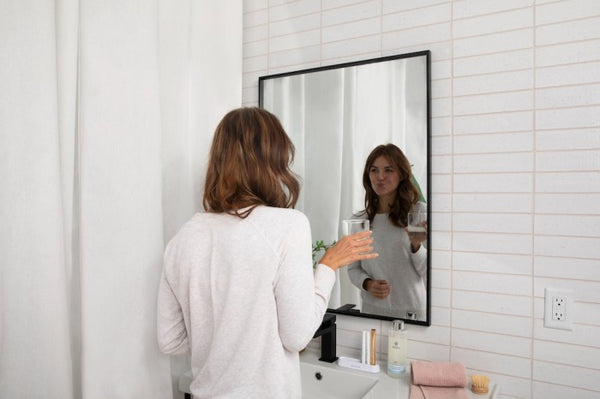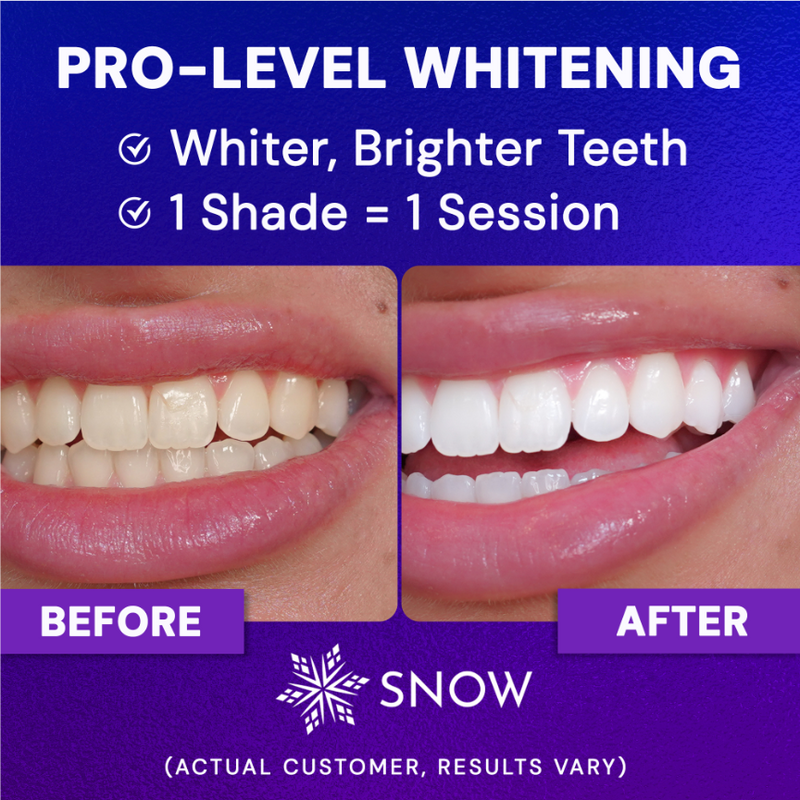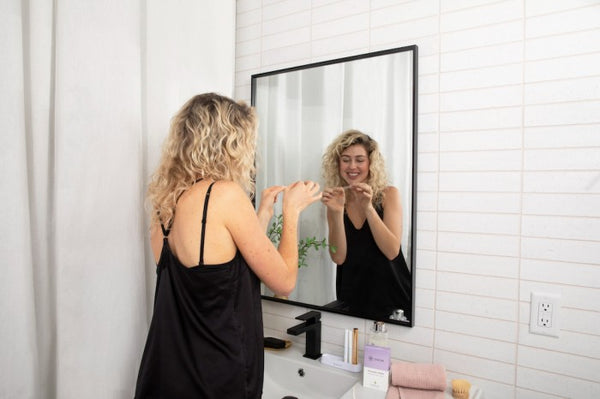Welcome to SNOW's comprehensive guide to teeth whitening!
Teeth whitening is a cosmetic dental procedure designed to lighten the color of your teeth and remove stains and discoloration. And you can do that from the comfort of your own home with SNOW's cutting-edge teeth whitening products.
Now, let's dive into what this article has in store for you. We'll explore nine different teeth whitening methods, including whitening toothpaste, strips, gels, foam, wipes, wands, mouthwash, lights, and serums.
Additionally, we'll discuss natural whitening remedies, effectiveness, safety, and the difference between at-home and professional whitening.
Stick with us to discover why SNOW is the best choice to get your teeth white. Let's get started!
What this article covers:
- What Is Teeth Whitening?
- 9 Teeth Whitening Methods
- How to Whiten Your Teeth Naturally
- What Is the Most Effective Way to Whiten Your Teeth?
- Does Teeth Whitening Work?
- At-Home Teeth Whitening vs. Professional Teeth Whitening
- Is Teeth Whitening Safe?
- Try SNOW: The Best Teeth Whitening System
What Is Teeth Whitening?
Teeth whitening is the process of brightening the color of teeth and eliminating stains and discoloration, providing a quick and effective way to enhance one's smile.
At SNOW, we understand the significance of a radiant smile and offer innovative at-home teeth whitening solutions to help individuals achieve their desired results conveniently and affordably.
According to GoodHousekeeping, our flagship Teeth Whitening Kit doesn’t just make your teeth white, it exceeds expectations. Here’s a couple of the reasons for these results:
- Safe And Effective: Our at-home teeth whitening products are designed with safety and efficacy in mind, allowing users to achieve professional-grade results from the comfort of their own homes.
- Convenient Application: With easy-to-use application methods such as whitening kits, pens, and strips, our products fit seamlessly into your daily routine, providing hassle-free whitening whenever you need it.
- Customizable Solutions: Whether you're targeting surface stains or deeper discoloration, our range of products offers customizable solutions to meet your specific whitening needs.
- Clinically Proven Results: Backed by years of research and development, our teeth whitening formulas deliver clinically proven results, helping you achieve a brighter, whiter smile with confidence.
9 Teeth Whitening Methods
At SNOW, we understand the importance of a radiant smile, which is why we offer a range of at-home teeth whitening methods tailored to your needs. Let's dive into the variety of options available:
Whitening Toothpaste
Kickstart your whitening journey with our Daily Hydroxyapatite Teeth Whitening Toothpaste. Designed with mild abrasives and polishing agents, it gently removes surface stains to reveal a brighter smile.
Teeth Whitening Strips
Experience convenience and effectiveness with our Magic Teeth Whitening Strips.
Simply apply these flexible strips coated with whitening gel directly to your teeth for hassle-free whitening at home.
Teeth Whitening Gels
Our Teeth Whitening Gel, as found in our teeth whitening kits, offers professional-grade whitening power.
Formulated with peroxide-based bleaching agents, it penetrates enamel to break up tough stains and discoloration.
Teeth Whitening Foam
Discover a gentler alternative with our Teeth Whitening Foam. This innovative option lifts surface stains without causing sensitivity, providing a comfortable whitening experience.
Teeth Whitening Wipes
Maintain your smile's brightness on the go with our Magic Teeth Whitening Wipes.
Our pre-moistened strips infused with whitening agents are perfect for whitening touch-ups at home.
Teeth Whitening Wands
Target specific areas with precision using the whitening serum wands found in our Wireless Teeth Whitening Kit.
The built-in applicator delivers whitening gel directly to your teeth, offering targeted whitening wherever you need it.

Teeth Whitening Mouthwash
Freshen your breath and maintain your whitening results with our Arctic Frost Teeth Whitening Mouthwash.
Infused with whitening agents, it helps remove surface stains while leaving your mouth feeling refreshed.
Teeth Whitening Lights
Enhance the effects of your whitening treatments with the LED mouth-pieces in our Teeth Whitening Kit.
The LED light accelerates the bleaching process, helping you achieve faster and more noticeable results.
Teeth Whitening Serums
For stubborn stains and discoloration, try our Teeth Whitening Serum. This concentrated formula targets tough stains with high concentrations of bleaching agents for dramatic whitening results.
With SNOW's range of at-home teeth whitening methods, achieving a brighter, more confident smile has never been easier.
How to Whiten Your Teeth Naturally
At SNOW, we understand the appeal of natural remedies for teeth whitening, but it's essential to approach them with caution when it comes to knowing how to whiten teeth.
While ingredients like baking soda, hydrogen peroxide, and activated charcoal may offer some whitening benefits, they also come with potential risks.
- Baking Soda: Baking soda is known for its mild abrasiveness, which can help scrub away surface stains.
- However, it can also be abrasive to enamel and lead to enamel erosion if used too frequently.
- Hydrogen Peroxide: Hydrogen peroxide is a common bleaching agent that can effectively whiten teeth.
- However, using high concentrations or applying it incorrectly can cause gum irritation and tooth sensitivity.
- Activated Charcoal: Activated charcoal is believed to absorb toxins and stains from the teeth.
- While it may provide temporary whitening effects, there's limited scientific evidence to support its long-term efficacy, and it can be abrasive to enamel.
While these natural remedies may offer some benefits, it's crucial to use them sparingly and under the guidance of a dental professional.
For safe and effective whitening, consider incorporating SNOW's at-home whitening products into your routine, which are formulated to deliver noticeable results without compromising your dental health.
What Is the Most Effective Way to Whiten Your Teeth?
At SNOW, we believe that the most effective way to whiten your teeth is with our at-home whitening kits. Here's why:
-
Professional-Grade Whitening: Our Teeth Whitening Kit is formulated with professional-grade ingredients to deliver exceptional results.
It contains a potent whitening serum and LED light technology, ensuring that you achieve a brighter smile in as little as 9 minutes a day. -
Convenience: With SNOW's at-home whitening kit, you can whiten your teeth on your own schedule, without the need for multiple dental appointments.
It's quick, easy, and hassle-free, allowing you to achieve a whiter smile from the comfort of your own home. -
Customized Experience: Our kit includes customizable mouth trays that mold to your teeth for a comfortable fit and even whitening results.
You can tailor the treatment to suit your individual needs and preferences, ensuring maximum effectiveness. -
Clinically Proven Results: SNOW's Teeth Whitening Kit has been clinically proven to whiten teeth by up to 8 shades in as little as 21 days.
Our customers rave about the noticeable difference they see after just a few uses, making it a trusted choice for effective teeth whitening.
When it comes to achieving a brighter, whiter smile, SNOW's at-home whitening kit offers unmatched convenience, effectiveness, and professional-grade results.

Does Teeth Whitening Work?
Yes, teeth whitening is indeed effective for lightening the color of teeth and removing stains.
Various methods exist, including at-home kits and professional treatments, each with different efficacy levels.
-
Effectiveness Of At-Home Whitening: Research shows that at-home bleaching with 10% carbamide peroxide provides stable and long-lasting results.
It's a safe and effective option for many individuals seeking to whiten their teeth. -
Comparison Of Whitening Techniques: Studies by the NCBI have compared different tooth whitening techniques, including at-home and in-office methods, showing no clinically significant difference in efficacy between the two.
Both approaches produced satisfactory and long-lasting results. -
Safety And Efficacy: Over-the-counter (OTC) whitening agents have been evaluated for safety and effectiveness compared to hydrogen peroxide.
Results demonstrate the efficacy and safety of OTC options for teeth whitening.
Teeth whitening is an effective option for achieving a brighter smile, but it's important to choose a method that suits your needs and consult with a dental professional for guidance.
At-Home Teeth Whitening vs. Professional Teeth Whitening
At-home teeth whitening kits provide a flexible solution for individuals seeking to brighten their smiles without the inconvenience of dental visits.
SNOW's at-home teeth whitening system offers several advantages over professional treatments:
- Convenience: With at-home whitening kits, you can whiten your teeth at your own pace and in the comfort of your home, eliminating the need for multiple dental appointments.
- Cost-Effectiveness: SNOW's at-home whitening system is a more affordable option compared to professional treatments, making it accessible to a wider range of individuals who may have budget constraints.
- Ease Of Use: Our at-home whitening kits are designed for user-friendly application, allowing you to achieve professional-quality results without specialized training or expertise.
- Flexibility: With at-home whitening, you have the flexibility to whiten your teeth whenever it's convenient for you, fitting into your busy schedule without disrupting your daily activities.
- Effective Results: Despite being used at home, SNOW's whitening system delivers professional-grade results, effectively removing stains and discoloration to reveal a brighter, whiter smile.
At-home teeth whitening with SNOW provides a convenient, cost-effective, and effective alternative to professional treatments, allowing you to achieve professional-quality results on your terms.
Is Teeth Whitening Safe?
Teeth whitening is generally safe when used correctly, but individuals may experience temporary side effects such as sensitivity or gum irritation. It's crucial to adhere to the instructions provided with the whitening product to minimize risks and maximize safety.
-
Temporary Side Effects: While rare, some individuals may experience temporary tooth sensitivity or gum irritation after whitening treatments.
These side effects typically subside after the treatment is complete. -
Follow Instructions: To ensure safety, it's essential to follow the manufacturer's instructions carefully when using at-home whitening products like SNOW's Teeth Whitening Kit.
Overuse or improper application may increase the risk of adverse effects. -
Consultation: If you have concerns about the safety of teeth whitening or experience prolonged discomfort after treatment, consult with a dental professional.
They can provide guidance and address any issues you may encounter. - Avoid Overuse: Using whitening products excessively can lead to enamel damage and increased sensitivity. Stick to the recommended usage frequency and duration to maintain oral health.
- Pre-Existing Conditions: Individuals with pre-existing dental conditions such as cavities, gum disease, or enamel erosion should consult with a dentist before whitening their teeth to ensure safety and effectiveness.
By following proper guidelines and using reputable products like SNOW's at-home whitening system, individuals can enjoy the benefits of teeth whitening with minimal risk to their oral health.

Try SNOW: The Best Teeth Whitening System
Are you ready to achieve a dazzling smile without the hassle of expensive dental visits? Look no further than SNOW's Teeth Whitening System!
Our at-home whitening kit offers professional-grade results in the convenience of your own home.
Here's why SNOW is the best choice for transforming your smile:
- Professional-Grade Whitening: With SNOW, you can expect results that rival those of professional dental treatments. Our advanced formula effectively removes stubborn stains and brightens your smile with ease.
- Safe And Effective: We prioritize your safety and satisfaction. SNOW's products are formulated using high-quality ingredients and undergo rigorous testing to ensure they are both safe and effective for at-home use.
- Backed By Research And Development: Trust in the power of science-backed innovation. Our whitening system is the result of years of research and development, ensuring you receive the best possible whitening experience.
- Convenience: Say goodbye to inconvenient dental appointments. With SNOW, you can whiten your teeth on your own schedule, whether it's while watching TV or catching up on emails.
- Cost-Effective: Save money without compromising on quality. SNOW's Teeth Whitening System provides professional results at a fraction of the cost of in-office treatments.
Don't settle for a dull smile any longer. Try SNOW today and discover the confidence that comes with a brighter, whiter smile!
Conclusion
Delving into various tooth whitening methods, the article underscores the importance of safe and effective practices when it comes to white teeth.
Highlighting the potential risks associated with aggressive bleaching, it emphasizes the need for caution.
While modern concepts show promise, such as natural teeth whitening techniques, our focus remains on preserving dental surface integrity. SNOW's commitment to safety aligns with these findings, offering gentle yet powerful teeth whiteners.
Elevate your oral care routine with SNOW's toothbrushes, seamlessly integrating teeth whitening into your daily regimen.
Did our blog meet your needs? You might also find our other guides helpful:
- Best Teeth Whitening Products for Sensitive Teeth
- Professional Teeth Whitening
- Permanent Teeth Whitening
- Types of Teeth Whitening Options
- Deep Teeth Whitening
- How to Whiten Between Teeth
- What Is Teeth Whitening?
- How to Keep Teeth White
- How White Are My Teeth?
- Should I Whiten My Teeth?
- Are White Teeth Attractive?
- How to Get a White Smile
- Getting Rid of White Spots on Teeth After Whitening
- How to Remove White Spots on Teeth at Home
- White Hard Stuff on Teeth




































































